Rounding the Baltic Sea
Northeastern Europe by Train (and ferry)
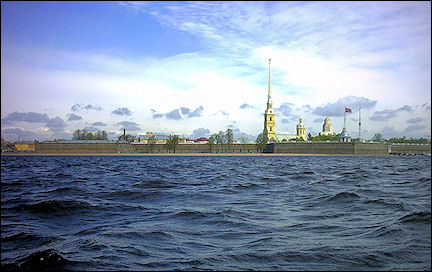
|
Rounding the Baltic Sea by train and ferry: First by railway to Nuremberg, via Leipzig and Berlin to Warsaw. Then by train via Vilnius to St. Petersburg to see the Hermitage Museum. By boat from Tallinn to Helsinki and from Turku to Stockholm. And finally by train via Copenhagen back to The Netherlands.
Travelogue and photos: Ton Groothedde
The first stop after the Dutch town of Hengelo is just over the German border in Bad Bentheim, where the engine is changed. After a short delay, we leave and pass Rheine, Osnabrück and Minden, where you can see the Wilhelm I Memorial high on a hill.
In Hannover we transfer to the train to Nürnberg. We pass through a pretty hilly landscape with fields of bright yellow rape.
Nürnberg
The Nürnberger Burg towers over the city
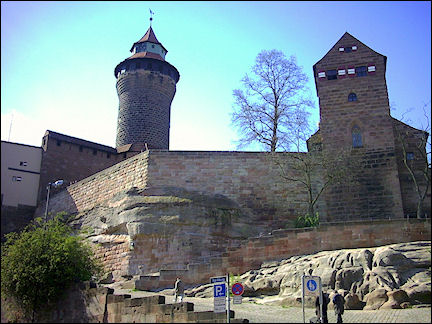
|
Our first impression of Nürnberg (Nuremberg) is good, it is a lively city. We walk to the Nürnberger Burg, which consists of the Kaiserburg and Burggrafenburg, which tower over the city.
After walking around the castle, we continue on our city walk and have a nice Weizenbier (wheat beer) in one of the many outdoor cafés.
We have dinner in a Frankish restaurant named Hütt'n ("huts"), where we have a Frankischer Platte: lots of meat, sauerkraut and undefinable Klöße, a kind of doughballs. It's tasty, except for the Klöße, and that for less than ten euro.
The former Reichsparteitag documentation center is in a suburb of Nürnberg. It gives a overwhelming impression of Hitler's National Socialist party center and the horrible ideas that were promoted from this place. After WWII the Nuremberg trials took place here.
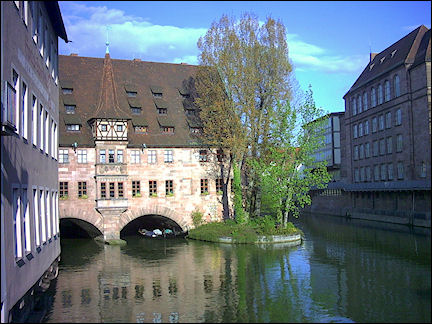
|
After leaving the Reichsparteitagsgelände we take the tram to the city center and wander through the Königstrasse and Handwerkerhof, after which we visit two churches, located accross the street from one another: the St. Martha and St. Clara churches.
Strolling through the beautiful city center, we also take a look at the St. Jacob, Our Lady and St. Sebaldus churches.
We also visit the city museum, called Fembohaus, where the history of Nuremberg is visualized. And then we take a look inside the Albrecht Dürer House, where this great artist lived in the sixteenth century.
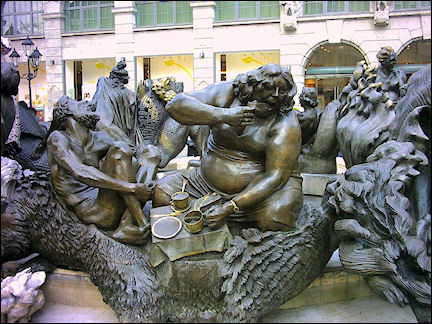
|
After absorbing this much history and culture, I really need a beer and try the authentic Schlenkerla Rauchbier, made by a brewery in Bamberg.
The beer tastes like smoked bacon, because during the process of brewing, beech-wood smoke is added to the malt, at least that is what I understood.
Leipzig
The former Stasi office is a museum now
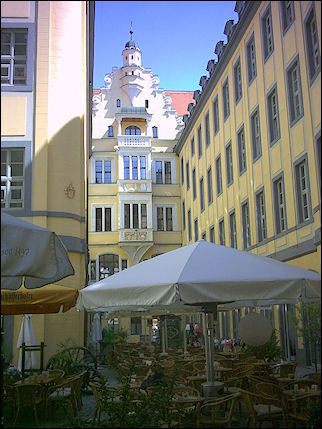
|
The train passes towns like Bamberg, Lichtenfels and Jena on its way to Leipzig. It is a beautiful, quiet ride through the Frankische Wald (Frankish Forest), a hilly region with fast-flowing brooks. Paragliders jump from hills and float in the sky.
Some of the towns we pass, have wonderful names, like Probstzella, Unterloquitz and Hockeroda.
In Leipzig's city center we first have a beer in the Nicolaistrasse. When we walk again, we arrrive at the Thomas Kirche, which isn't all that special as far as I'm concerned. In front of the church is a statue of the composer Johan Sebastian Bach, which is being photographed from every imaginable angle by a group of Japanese tourists. Inside the church is Bach's tomb.
The square with the old City Hall and the historical city museum is worthwhile.
We visit the Zeitgeschichtliches Forum (Contemporary Forum), where the exhibition paints an image of Germany from the division after WWII through the reunification to now. It's extremely worth a visit.
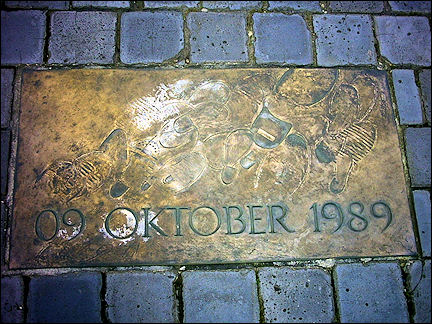
|
After our visit to the Zeitgeschichtliches Forum we stroll to the Nicolaikirche, where the 1989 revolt started.
We didn't plan to spend much time in Leipzig, but we still have a few hours before we take the train to Berlin.
We first take a look at the Nicolaikirche, which is beautiful on the inside, not so much on the outside. Then we visit the Rundecke Museum, which used to be the Stasi office under Communism. We learn a lot about the modus operandi of the DDR secret service. Walking from room to room, we are led through the history of the Stasi and we find out about the sometimes disgusting ways they worked: disguises, spy attributes like suitcases with hidden cameras, fake noses and mustaches.
Berlin
The Brandenburger Tor looks a little lost
After a smooth trip with the InterCity Express (ICE) train we arrive in Berlin. We take the subway to the Kurfürstendam with the Gedächtniskirche (Memorial Church, a WWII memorial) which is beautifully illuminated.
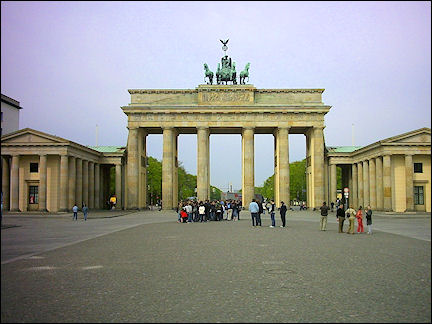
|
After breakfast we take the subway to the Potsdammer Platz. It has been developed beautifully, but just after the reunification in 1989 it was one big construction site. We continue on our way through the Strasse des 17 Juni, which leads to Unter den Linden via the Brandenburger Tor.
The 18th century Brandenburger Tor is the only remaining city gate in Berlin. The gate looks a little lost in its modern surroundings.
We walk to the Reichstag, the German Parliament building, which was completed in 1894. The Reichstag is maybe best know for being burnt down in 1933 (as a protest against Hitler's power grab in that year).
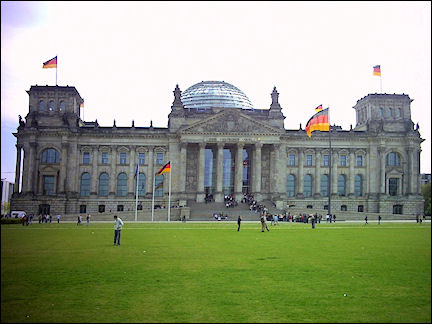
|
At the end of WWII there was a huge battle for the Reichstag, until the Russian army was able to raise the flag on the building in 1945. The Reichstag wasn't used as the seat of Parliament until 1990.
After the reunification of Germany, there was an increasing demand to restore the function of parliament building to the Reichstag and thus happened.
When we have seen the building from all sides, we continue on to Berlin's Central Station, a beautiful modern construction, of which especially the main entrance draws attention with its huge glass front.
We find out from which platform the train to Warsaw will leave tomorrow and then go on to the Kurfürstendam. We visit a church opposite the Gedächtniskirche, a modern building with all kinds of blue lights.
Via the Gedächtniskirche, which was heavily damaged during WWII, we go to the Europe Center. There we take the elevator to the twentieth floor, where we have a great view of Berlin in the panorama café.
After lunch we take the subway to the Alexanderplatz, the central square in East Berlin during the DDR era, where many government buildings were located. It is a busy traffic hub, with as its main attraction the television tower.
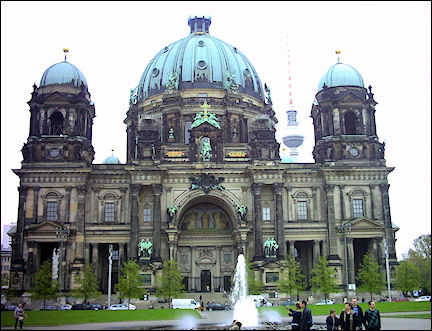
|
We stroll on to the cathedral, a beautiful building which also houses the tombs of many Hohenzollern kings (Germany's royal family before it became a republic).
Then on to the red-brick Berliner Rathaus (former City Hall) and another stroll on Unter den Linden, with many old buildings on both sides.
We enter the Friedrichswerdersche Kirche, a Gothic Revival church, built in the first half of the nineteenth century. The church was severely damaged in WWII and was restored in the 1980s. The church has beautiful stained glass windows and an equally nice statue gallery.
In an outdoor café on Unter den Linden we have a beer and when we are rested, we continue on our way to the memorial voor de murdered Jews of Europe, the Holocaust Memorial.
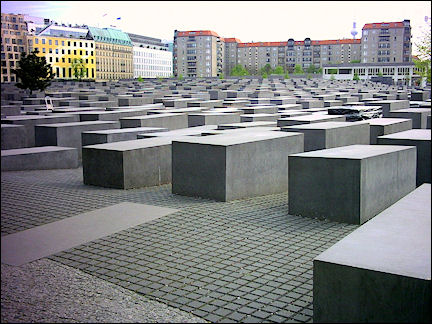
|
The memorial is located next to the Brandenburger Tor and was built between 2003 and 2005. It consists of 2711 concrete blocks, so-called stèles, laid out in a kind of grid pattern.
You can walk between the blocks, a kind of modern maze, but without the dead- end paths. The height of the stèles varies from just above ground to over four meters.
We visit the documentation center, which has an impressive exhibition about the persecution of the Jews. In several rooms, like the Room of Dimensions, the Room of the Families and the Room of Names, family histories are told, with biographies of Jewish families.
We continue on to Rathaus Schöneberg, which used to be the political center of West Berlin before the reunification. The Rathaus is probably best known as the spot where President John F. Kennedy held a speech in 1963 with the (in)famous words "Ich bin ein Berliner" ("I'm a doughnut").
Warsaw
An over 200 meters high present from Stalin
We board the train for the six hours long trip over 560 kilometers to Warsaw. After the border town of Frankfurt an der Oder we pass vast birch woods and towns like Rzepin, Boczów, Torzym, Toporow, Kupinino, Poràzyn and Otusz. The landscape varies from flat to hilly.
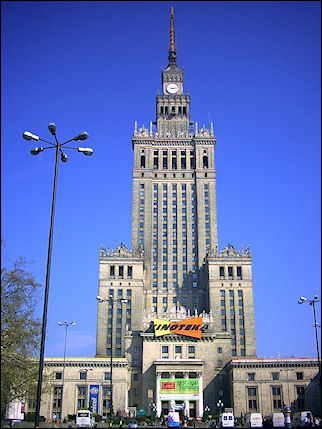
|
Via Zbaszynek and Kutna we arrive at Poznan Glowny, Poznan Central Station. On the way we see many pretty houses being built. Poland seems to be catching up with its backlog in housing. Early in the evening we arrive in Warsaw.
After a good breakfast we walk to the old city center. The weather is fine and the bums in the city feel the same way: they gather in many places to drink their beers.
We pass the Cenral Station and the first building we notice is the grotesque Culture and Science Palace, a "present" from Stalin, shortly befor his death.
It is an over 200 meters high skyscraper which dominates its surroundings with its bombastic looks. Nowadays it's mainly in use of office and exhibition space.
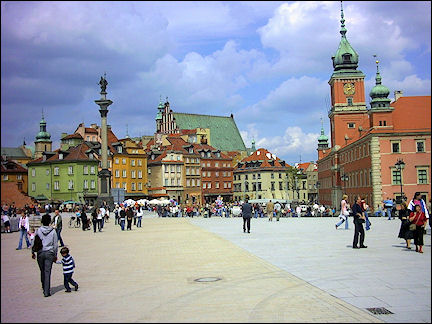
|
Walking in a beautiful park we pass the pretty opera building and then enter the old city center. The first thing we notice on the large and lovely square with castle, is the King Zygmunt column. This king moved the seat of government from Krakov to Warsaw.
The king is portrayed with a large crucifix in his right hand. Next to the king's column the Zamek Krolewski - the royal palace - stands out. The red-brick building occupies a large part of one side of the square.
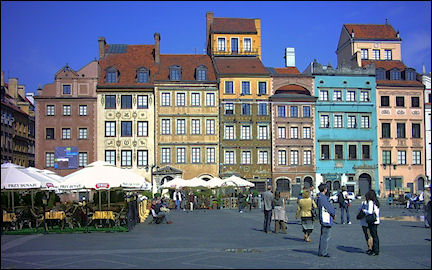
|
Via narrow streets with cobblestones we arrive at the central square of the old city, Rynek Stare Miasto. The beautiful square is completely surrounded by tall, colorful old buildings. There are only narrow streets leading to the square.
Fragments of music blow over the square where outdoor cafés offer the opporunity to take in the hustle and bustle while enjoying a cup of coffee.
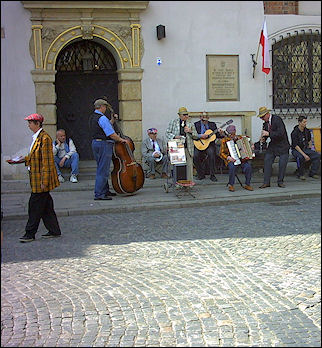
|
From the square we walk via a gate and a pretty street with old buildings to the old fortress walls just behind the square. We take a walk on the walls and then return to the square.
We enjoy the laid-back and lively atmosphere. It's May 1st and this day is celebrated in grand style. The Poles have the day off and you can tell, it's getting more crowded by the minute.
After visiting several churches, with frequent views of the Wisla river, we arrive at the memorial for the Warsaw Uprising. The memorial commemorates the tens of thousands of Polish, mostly Jewish citizens, both soldiers and civilians, who fought the German occupation.
We take a taxi to the Jewish Ghetto, where the Umschlagplatz is. There, over 300,000 Jews from the ghetto were dragged to German extermination camps like Treblinka.
Vilnius
People are singing at the sixteenth century Aušros Gate
The train ride to Vilnius, the capital of Lithuania, takes almost ten hours. We see many deer and roe just off the railway tracks.
The landscape becomes hillier after Bialystok and we see more and more storks on their nests. All fruit trees are blossoming, which looks wonderful. The lakes area around Augustow is beautiful, too.
Via Suwalki we arrive in Sestokai, where we transfer to a Lithuanian train. Soon we ride in a rural area, which looks much poorer than those in Poland at first sight. The houses are usually small and made of wood and it seems that everyone has their own kitchen garden. The area is very wooded.
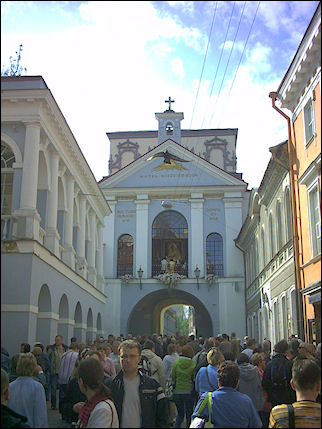
|
After eight hours the fatigue gets to us; fortunately we arrive in Vilnius at 5 PM.
Vilnius has many beautiful churches. Because visiting a church doesn't take much time, we always include a few during a city walk. The first is the Church of the Holy Spirit, a Russian Orthodox monastery church, green and pink on the inside. The nearby St. Theresa church is pink and blue inside.
When we arrive at the 16th century Aušros Gate, a crowd of people is singing in the street. Over the gate is a small chapel with a Mary statue, and it's a place of pilgrimage for many catholic Eastern Europeans. It's very busy and we have a hard time getting to the stairs to the Mary statue.
Via the pink-and-white Baroque Casimir church, the oldest church here, we stroll to the Old City Hall. After having explored a few more churches, we have a cup of coffee in the cobbled Pilies gatvé. This is the former Fortress Street, which dates from the Middle Ages and now is a busy shopping street which also has many restaurants.
It's incredibly busy and the weather is wonderful, so people are parading. I suspect that it's some kind of holiday, because there is music and there are stalls where all kinds of stuff are sold.
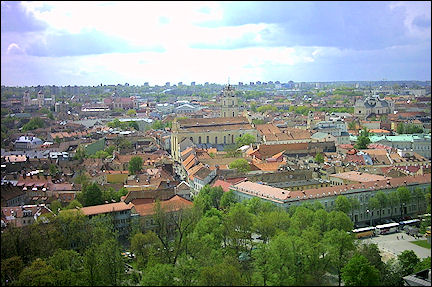
|
After a few cups of coffee and taking in the street scenes, we continue on to the Fortress Mountain. On top of the 50 meters high "mountain" stands a red-brick tower, which sports the Lithuanian flag.
We have a great view of the city from the fortress, but also of the Crucifix Mountain, where three large white crucifixes stand.
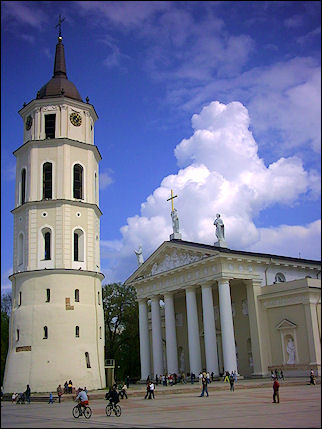
|
According to legend three monks where killed and buried there. During the Soviet rule the crucifixes were removed by the Russians, but after independence the memorial was restored.
Before lunchtime we also visit the Vilnius cathedral and its white belltower on the large Cathedral Square, where it's very crowded. This is one of the main spots to hang for Vilnius' youngsters, who rollerskate, skateboard or just hang out.
We visit the Anna church and the Bernardus church and belltower next to it. They are Gothic, red brick buildings.
We also visit the synagogue and after that it's been enough for today.
We wander a bit more and conclude the day with some beer that we - at least, we think so - have earned.
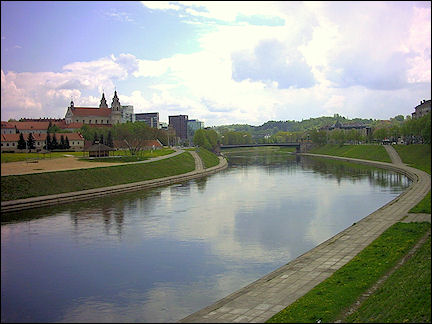
|
Before we board the train to St. Petersburg we go on one more walk in Vilnius the next morning. First to the KGB Museum, which turns out to be closed. Then a stroll along the Neris river and a look at the Frank Zappa Memorial, made by a group of artists from Vilnius.
A quick visit to the presidential palace and then on to the authentic Lithuanian restaurant Forto Dvaras, where we try some dishes that I still can't describe. But it's tasty, and also greasy.
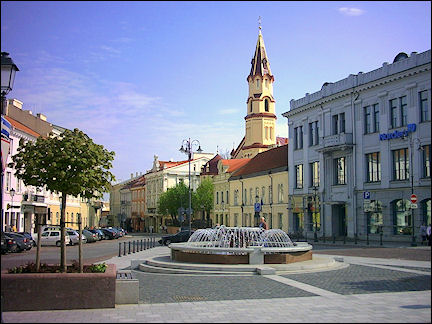
|
We visit the amber museum. Amber is petrified, millions of years old resin. It's interesting to see how insects got trapped in the resin and were petrified with it. In the clear stones we see flies, midgets, ants and cockroaches, all of them tiny.
St. Petersburg
Enjoying the splendid panoramas from the Neva bank
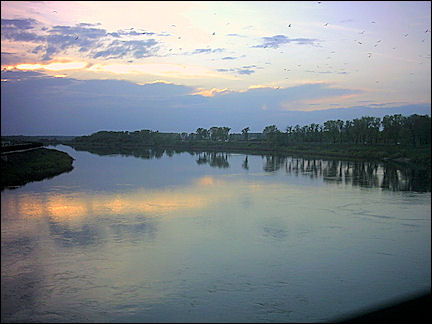
|
The train to St. Petersburg is waiting for us on the Vilnius train station. It will pass through Latvia and then cross the border into Russia.
It's incredibly busy at the St. Petersburg train station. We change some money and take a cab to Nevski Prospect, St. Petersburg's most famous street. The first driver doesn't feel like taking us, his colleague charges way too much, but because we don't feel like taking a bus, we accept his offer.
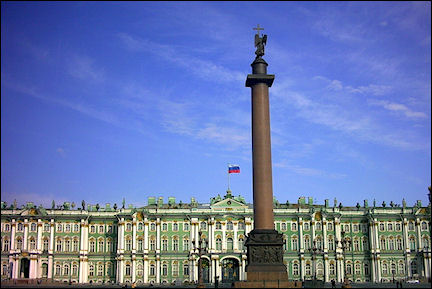
|
After breakfast in our hostel on Nevski Prospect we go out and when we turn a corner we immediately see the Hermitage on a huge square. From the corner we see the Admiralty and the St. Isaac Cathedral. We walk on along the Neva river and see the Peter and Paul fortress on Hare Island in the distance.
We take a boat trip on the Neva. It's an old boat with simple, very old tables and chairs. We sail on the river and the boat dances on the rather strong waves.
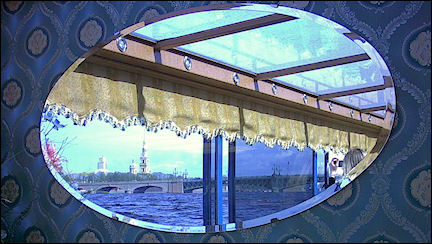
|
We enjoy the wonderful views. We sail along the backside of the Hermitage, see the Admiralty and get close to the Peter and Paul fortress.
Back on land we visit the St. Isaac cathedral, where we gape at the enormous bronze doors, which are decorated with beautiful statues. The cathedral is a tall building and has a huge dome and wonderful statues hanging from the ceiling. It also has great paintings and pretty mosaics. The walls of the cathedral are painted in pastel colors.
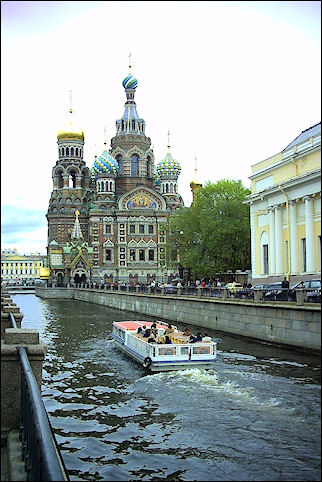
|
From St. Isaac cathedral we walk down Nevski Prospect, passing the Kazan cathedral. In a parallel street is the Sobor Spas na Krowi, the church of the Resurrection of Christ.
We pass a military parade on the large square at the Hermitage, which makes us really feel that we're in Russia.
The Hermitage is a huge museum. We decide to only see the Dutch, Flemish, Spanish and Italian masters, as well as the antiquities department. This limited program already takes about three hours.
We see many works by, among others, Rembrandt and his students, Paulus Potter, Ferdinand Bol, Rubens and Jan Steen. Wonderful art in a beautiful building with an exquisite interior.
After we have seen everything we wanted, we decide to walk to the Peter and Paul fortress. It's a long walk along, and crossing, the Neva. We visit the bastion in which people used to be held prisoner. On surrounding beaches on the river, people in bathing suits are catching a little sun.
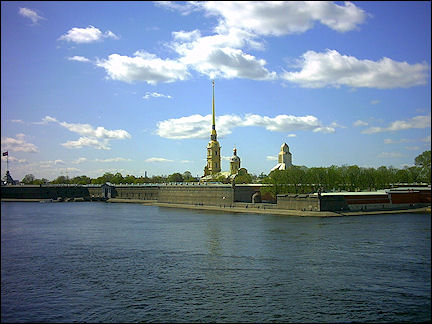
|
We walk back from the picturesque streets in the fortress via the Marching Field, the square where parades are held and where an eternal flame burns. We also explore the largest department store in the city, Gostinyi Dvor, which used to be a Chamber of Commerce. The galleries are beautiful.
In the evening I go out by myself and stroll to Rossi Street. It's remarkable that, now that I am by myself, I am greeted frequently by Russian ladies, in English with heavy Russian accents, every now and then accompanied by a wink.
Once in Rossi Street, I immediately see why it's famous. Both sides of the street are uniquely symmetrical, the soft-yellow and white houses opposite each other have doors, windows and decorations in exactly the same places. It's not a big street, but this creation of architect Carlo Rossi is definitely worth visiting.
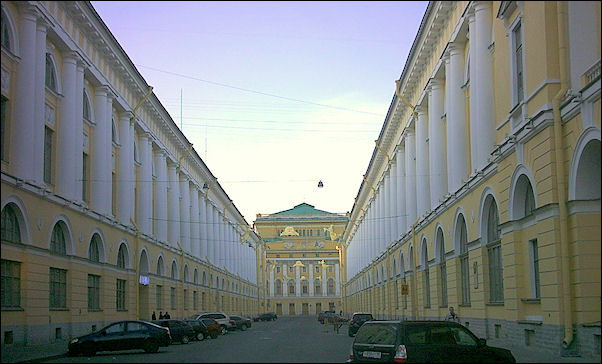
On our last day we visit the St. Peter church, the protestant church of the German community in St. Petersburg. Its interior isn't overly interesting and it has stands for visitors. A little strange in a church.
St. Petersburg is swamped with churches, so we decide to see another one: the St. Catherine church, which has beautiful pastel colors, but now it's been enough.
We stroll to the Russian Museum. Czar Alexander II had this museum housed in the former Michailovski Palace. It is a beautiful building, both inside and out. And it's worthwhile to see the art of Russian masters from close up.
To conclude our stay, we visit the Pushkin Museum and the Summer Garden, the former being Pushkin's last house, the latter a garden with wonderful marble statues. The park on an island used to be Pushkin's favorite park, which he often visited.
Before we get in the taxi to the train station, we pay a quick visit to the splendid Kazan cathedral, which meanwhile has become an Orthodox church, after having housed a museum for a long period of time.
Tallinn
'Your adventure in Russia is not over yet'
I have a bad feeling: our visas will expire today and if I don't misread the Cyrillic on our schedule, the train reaches the Estonian border only after midnight. The conductor confirms this.
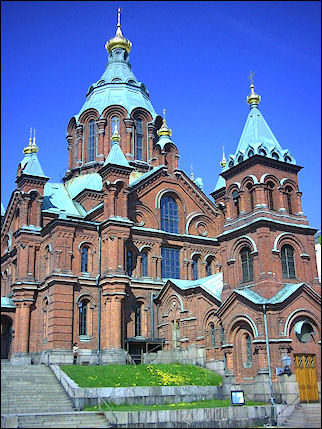
|
When the train stops at the Ivanova border for the exit check, the door of our compartment is opened and the conductor points at us. The customs officer leafs through our passports and shakes his head with a pitying expression. It's 0:58, so our visas are expired for almost an hour. His colleague, with an even bigger hat, says with a heavy Russian accent: "Your adventure in Russia is not over yet." We have to leave the train.
A night of waiting follows in a customs office with unpleasant Russians, a taxi drive in a delapidated Lada to a remote police office where we are finger- printed, taxi drives to a photographer for photos and to a bank to withdraw money and pick up new visa forms.
When we are waiting in line at the bank, I see a female officer who we saw in the custums office stand in the line next to ours.
It's not the only time we notice that they are keeping an eye on us. Only at the end of the afternoon our passports are returned and we are hushed out of the customs office with a visas.
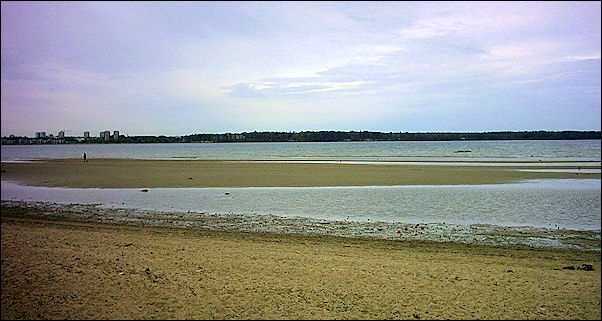
Our day in Tallinn is over. After a taxi ride to the border and a bus ride to the Estonian capital it's already evening. We walk to the beach, have a beer and that was it for our stay in Tallinn.
Afer breakfast we take a short walk to the beach and then take a cab to the D-Terminal to board the ferry to Helsinki.
Helsinki
A nice city for shopping, I guess
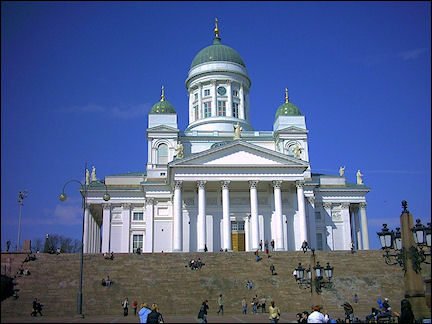
|
After checking in in our beautiful hotel in the city center of Helsinki, we first walk to the train station to check the departure time for the train to Turku. Then we walk to Senate Square with the Helsinki cathedral, which is pretty on the outside, but bare inside.
The nearby Uspenski cathedral is beautiful on outside and inside. Our walk takes us farther to the presidential palace and City Hall.
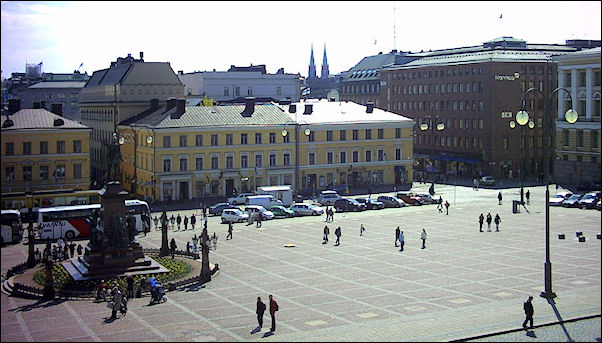
On a kind of marketplace are performances by several music groups and we can taste delicious Lapp fish specialties. We visit the Temppelianskio church, which is carved out of the rocks. The church is closed, but one look though its glass door makes us think the interior is probably beautiful.
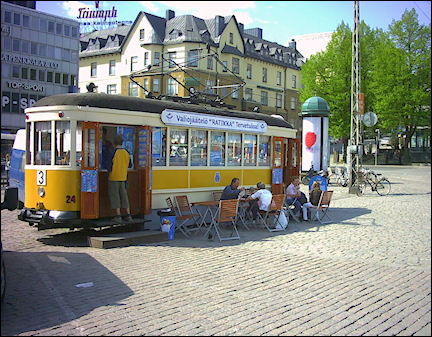
|
Helsinki is nice and lively city, especially for shopping, I guess, but we aren't here for that. There aren't too many sights; and it's an expensive place.
Turku
There are restaurant boats in a canal
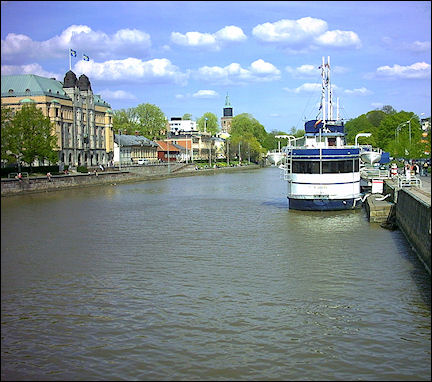
|
After an excellent breakfast we take a stroll on the Helsinki marketplace and then take the train to Turku, where we will board a ferry to Stockholm tomorrow. The train takes us through a pretty landscape with many wooden houses and forests.
The town of Turku has a lively town center and is pleasant because of its many outdoor cafés. There are some restaurant boats on a canal that runs through Turku.
We visit the nice cathedral and have half a liter of beer for € 2.50 which is very cheap in Finland. So we have another one, and eh, oh well, another one. After the so far exhausting trip it's great to relax.
Stockholm
The ferry takes us through enchanting surroundings
We have to get to the port early, so we are ready at 6:30 AM for the taxi that takes us to the terminal. The crossing to Stockholm will take about eleven hours, the ferry is extremely slow. Once on our way, it becomes clear that we sail through enchantingly beautiful surrounding.
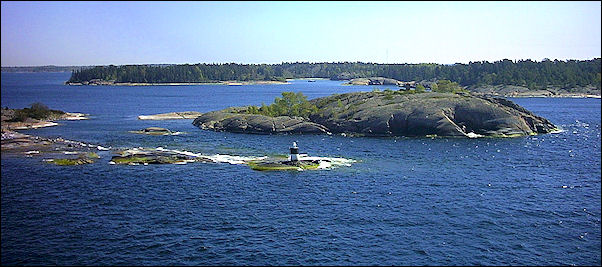
Until our first stop in Mariaholmn on the Åland Islands, the ferry sails between islands. The views are really wonderful and even though the pace is slow, times flies.
Around 1 PM we dock in Mariaholmn, where passengers debark and others board; the same goes for cargo.
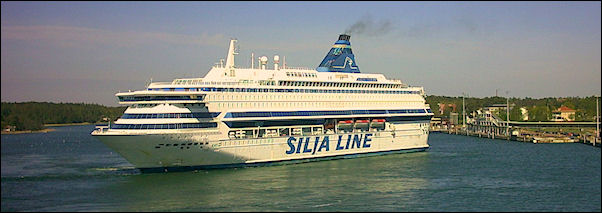
After this short stop in Mariaholmn we enter open sea. After less than an hour we already see little islands appear on the horizon again.
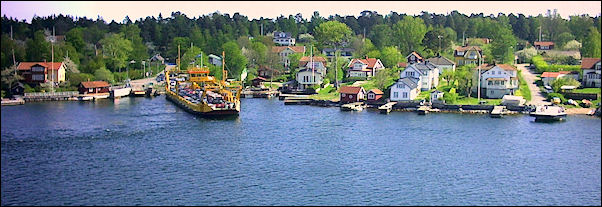
Again our route is beautiful, especially when the Swedish mainland gets into view. The pretty Scandinavian houses on the wooded islands look amazing.
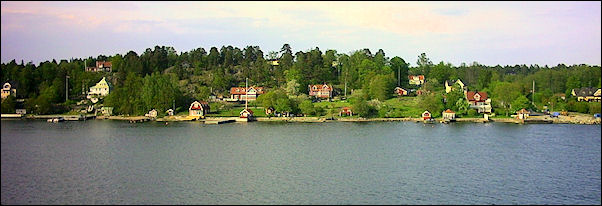
Our first impression of Stockholm is overwhelming; tomorrow we'll have time to explore.
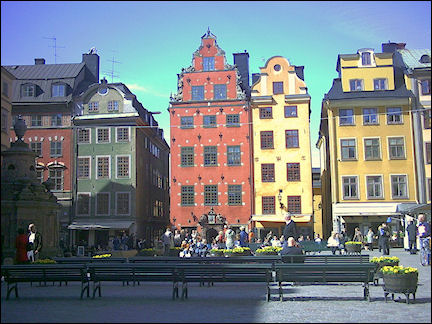
|
Today we go out to see the city. We first visit the old district Gamlastan, where we stroll leisurely.
We visit the nearby Riddarholmskyrken (church) and on the Evert Taubes Terrass we have a great view of the Stadshuset (City Hall).
Via Storkyrkan, the church of the bishop of Stockholm, we walk to the royal palace, where we see the changing of the guards. There are many pretty, almost Italian looking streets in this neighborhood, where it's pleasant with nice and warm temperatures.
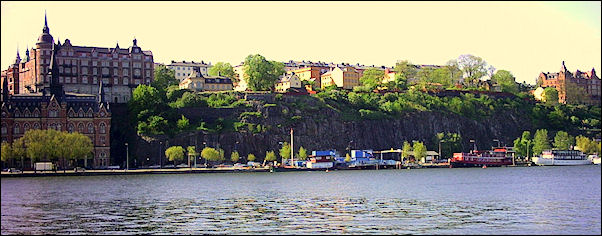
We visit the German church which has beautiful stained-glass windows and a fabulous altar. Via the market building and the historical museum, we walk along more typical churches.
Copenhagen
The Rathusplatsen is lively and crowded
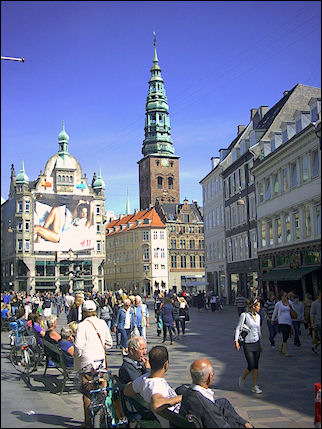
|
We take the train to Copenhagen, our final destination. The train to Malmö goes through a wonderful Swedish landscape and along towns like Södertalje, Katrineholm, Norrköping, Linköping and Sävsjö. The typical Swedish houses stand out in the rolling landscape. After passing Linköping the ride goes through a wonderful lake region.
In Malmö we transfer to the train to Copenhagen Central. Because I have visited here before, we limit ourselves to a stroll in the city. First to the Rathusplatsen, which is lively and crowded and where you can see the amusement park Tivoli. Then we walk to Slotsholmen via the shopping street Ströget.
After a stroll on the H.C. Anderson Boulevard we take the train to Hamburg and then to the Dutch town of Hengelo. It's over.